Главная страница » Portfolio » Steel shot » Spherical steel shot DSTU 3184-95
Cast steel shot DSTU 3184-95 (GOST 11964-81)
Grupa Przemysłowa PPW sp. z o.o. sells cast shot of the following grades in accordance with DSTU 3184-95 (GOST 11964-81):
- Steel cast shot (DSK)
- Improved cast steel shot (DSKU)
- Cast iron shot (DCHK)
TECHNICAL SPECIFICATIONS
| Fraction number | Screen hole sizes, mm | Permissible residue content on the sieve |
| 0,3 | 0,2 | min. 85% |
| 0,315 | min. 70% | |
| 0,5 | max. 12% | |
| 0,63 | max. 1% | |
| 0,5 | 0,315 | min. 85% |
| 0,5 | min. 70% | |
| 0,8 | max. 12% | |
| 1 | max. 1% | |
| 0,8 | 0,63 | min. 90% |
| 0,8 | min. 80% | |
| 1,25 | max. 6% | |
| 1,4 | max. 1% | |
| 1,0 | 0,8 | min. 90% |
| 1 | min. 80% | |
| 1,4 | max. 6% | |
| 1,6 | max. 1% | |
| 1,4 | 1,25 | min. 95% |
| 1,4 | min. 80% | |
| 2,2 | max. 1% | |
| 1,8 | 1,6 | min. 90% |
| 1,8 | min. 80% | |
| 2,8 | max. 1% | |
| 2,2 | 1,8 | min. 95% |
| 2,2 | min. 80% | |
| 3,2 | max. 1% | |
| 2,8 | 2,2 | min. 95% |
| 2,8 | min. 80% | |
| 3,6 | max. 1% | |
| 3,2 | 2,8 | min. 90% |
| 3,2 | min. 75% | |
| 4,5 | max. 1% | |
| 3,6 | 3,2 | min. 94% |
| 3,6 | min. 85% | |
| 5,5 | max. 1% |
CHEMICAL COMPOSITION:
DSC / DSCU Grades
- Carbon (C): 0.75 – 1.10%
- Silicon (Si): min. 0.40%
- Manganese (Mn): 0.60 – 1.20%
- Phosphorus (P): max. 0.05%
- Sulfur (S): max. 0.05%
- Iron (Fe): balance
PHYSICAL PROPERTIES
| Parameter | DSC | DSKU |
| Solidity | 545 — 830 HV | 365 — 545 HV |
| Density | min. 7200 kg/m3 |
OVERVIEW
Cast steel shot is typically formed as small spherical particles of steel or cast iron with various diameters. It undergoes a multi-stage classification process to ensure uniformity in particle size and consistency. Each batch is also monitored for shape and hardness.
In some contexts, fine steel shot is referred to as “steel sand,” drawing a parallel to quartz sand. However, cast steel shot is significantly more durable and easier to regenerate during surface treatment processes. This is particularly true for the improved DSCU grade. For comparison, typical sandblasting media can lose up to 15% of volume per day, whereas cast steel shot shows wear of no more than 19% per month.
Why Steel Shot Remains a Popular Choice?
The use of steel shot for mechanical surface cleaning dates back to the 19th century and remains one of the most effective methods to this day. It is commonly used to remove:
- Mill scale after rolling or heat treatment;
- Molding sand adhered to castings;
- Rust, dirt, and old paint;
- Organic contaminants and residues.
In addition to cleaning, shot blasting also compresses the surface layer — a process often referred to as “micro-forging.” This enhances fatigue resistance and extends the lifespan of treated parts by reducing the risk of microcracks forming.
Another benefit of blasting with fine shot particles is the creation of a uniform, matte finish. This process also helps eliminate small imperfections and surface pores.
What Influences the Effectiveness of Shot Blasting?
The outcome of a shot blasting process heavily depends on the hardness and mass of the shot. The energy delivered on impact is directly proportional to both the weight and velocity of the particles. For optimal results, in addition to adjusting the blast pressure and nozzle diameter, it’s crucial to select the right shot size based on material thickness and desired finish quality.
Larger particles clean more aggressively but can damage delicate surfaces and consume more air per unit of cleaning. Finer particles create a cleaner finish but may require longer processing times.
Why Choose Shot Blasting Over Sandblasting?
Shot blasting is often favored over sandblasting due to improved safety for operators. Studies have shown that steel dust is generated in significantly lower quantities than quartz dust and is easier to capture with standard filtration systems.
Moreover, quartz dust is a known cause of silicosis, a serious occupational disease common in dusty work environments. Using steel shot helps reduce health risks and creates a safer work environment overall.
Need Help Choosing the Right Steel Shot?
Our experts are ready to help you select the appropriate shot size and process settings based on your specific needs. Contact us for a professional consultation.
